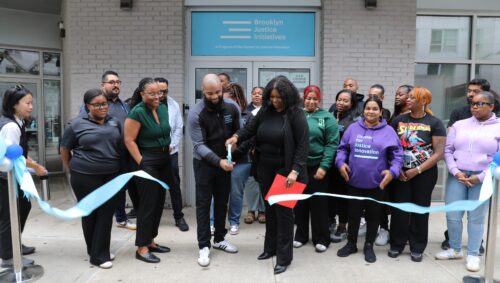People awaiting trial in East New York can now find vital resources closer to their own communities.
In East New York, people awaiting trial from their community can now access crucial services closer to home.
For years, the Center for Justice Innovation has been a provider of New York City’s Supervised Release Program—an alternative to bail that ensures people make their court dates while connecting them to resources in their own communities. Besides preventing the harms of jail, it also opens doors to services for housing, employment, mental health, and other needs.
As part of their court mandates, Supervised Release participants attend regular check-ins with a case manager while their case makes its way through the courts. With the new office in East New York, Brooklyn residents can now make those check-ins more easily in an environment where they feel comfortable asking for support.
We’re putting ourselves in a community where there’s a feeling of security and safety, in an area that feels a lot more familiar.
The opportunity for a new location came with the expansion of Supervised Release in Brooklyn, which had previously been based solely near the borough’s main courthouses downtown. That came with obstacles for many people—a long commute, and negative associations with an area almost synonymous with the criminal legal system.
“We’re breaking away from being downtown, where a lot of our participants feel trauma from being so close to the courthouse,” said Curtis Huggins, Director of Community Initiatives at our Brooklyn Supervised Release Program. “And we’re putting ourselves in a community where there’s a feeling of security and safety, in an area that feels a lot more familiar.”
The space also includes a community hub and garden, where participants can take a breath, socialize, or work on resumes and job applications in a welcoming environment—even outside of their scheduled appointments.
“We have housing and employment specialists who come once a week and do a class here,” said Shaquille Campbell, a Community Engagement Specialist at the program. “We have hot meals. And we have barbershop events, where a professional barber comes through and gives haircuts.”
The decision to locate the new office in East New York was informed by both rigorous data analysis and the close-up perspective of our staff on the ground. Our data team started by compiling information about participants who were struggling to make their check-ins to figure out where they might benefit from a new community site.
“We highlighted certain areas of the boroughs where participants were having difficulty attending those check-ins or were far away from services,” said Daniel O’Brien, Senior Data Analyst at the Center. “When you see a whole neighborhood with a high rate of missing check-ins and a high rate of employment need, you can take a step back and say, ‘We need to provide more services there.’”
We try to show that we’re here to help—whatever needs you have, we’re here to cater to.
We also invited our Brownsville Community Justice Center team to join in the planning process, drawing on their years of experience in the community and their relationships with a wide range of local organizations and service providers. Staff weighed in with crucial insights about barriers people might face at certain locations and how to make the space as inviting as possible.
That hyper-local perspective proved crucial to painting a broader picture that can’t be seen from data alone, like which locations would feel safe and accessible for those living in the area.
Like many of our other programs across the city, our new office in East New York is staffed in part by people who are from the neighborhood themselves. That creates an added layer of trust and comfort, something that’s often hard to find in spaces associated with the legal system.
“A lot of times, participants are coming from a system where they’re being mistreated or judged,” said Community Navigator Elvin Severe. “We try to show that we’re here to help—whatever needs you have, we’re here to cater to.”
